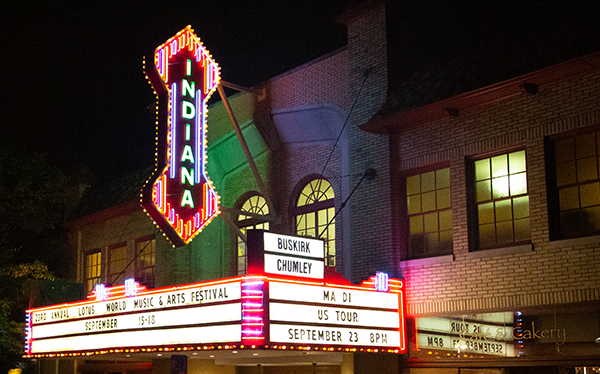
Our newest local documentary, The Indiana Theatre at 100: The Evolution of the Buskirk-Chumley, premieres Thursday, February 9 at 8 p.m on WTIU. Producer Jim Krause discusses the hidden charms of this iconic institution and highlights the numerous trials it’s faced in this interview:
Q. Take us back to December 1922, when the Indiana Theatre was born. What was the audience experience like there in those early days?
A. When the Indiana Theatre opened in 1922, it was well before the time of TV, so going to the theater to see a movie was a new and exciting experience. Many theaters were built as “movie palaces”—they had ornate styling and fanciful architecture. People got dressed up to go out and were treated almost like royalty by the ushers, who typically wore matching uniforms. Going to the theater was as close to meeting movie stars as one could usually get.
Q. Over the last century, the Buskirk-Chumley has faced times of war, economic depression, and even the threat of fires. In your opinion, what was the lowest low point for the theater? When did things look most dire for the establishment?
A. There were several tough times for the Indiana Theatre, which later became the Buskirk-Chumley Theater (BCT). The first was the fire in November of 1933, when it nearly burned to the ground. But the Vondershcmitts, with their small empire of theaters, had the funds to quickly rebuild.
The next lowest time was when Kerasotes closed it in 1995. This was before it was gifted to the Bloomington Area Arts Commission (BAAC). It was closed for a while before Kerasotes gave it to the BAAC—and even then, its future was uncertain, as there was a possibility of selling it or tearing it down. The most recent difficult time was during the Covid-19 pandemic. The BCT was shuttered in March of 2020, not to reopen until fall of 2021. Many theaters went out of business due to the pandemic, but the BCT survived.
Q. What are some of your favorite shows and acts that have performed at the Buskirk-Chumley over the years?
A. Some of my favorite shows at the BCT include the Cardinal Stage (now Constellation) performance of the Wizard of Oz, Bela Fleck and Abigail Washburn, Patty Larkin, Richard Thompson, Lotus Festival, Malcolm Dalglish’s the Welcome Table, and performing there a handful of times. The size is just right. There’s not a bad seat in the house. It’s a great place to see a show or to perform in one.
Q. What distinguishes the Buskirk-Chumley from similar theaters? What continues to makes it so unique and iconic in the 21st century?
A. The fact that the BCT was carefully and painstakingly renovated to such a great degree sets it apart from most theaters—whether new or old. It’s a National Historic Landmark because it’s been renovated with such care. Going to a show at the BCT is like taking a time machine back to 1922. It looks similar to how it appeared when it first opened but now has state-of-the-art lighting and sound and a digital projector for movies. It’s great that you can also get local craft beer and gourmet chocolates.
Q. What shift or pivot in the theater’s history was, in your opinion, most imperative to its success?
A. The City of Bloomington taking ownership of the building along with the formation of BCT Management in 2001 is why we still have it today. But none of this would have happened without the vision of Frank Young and his and the BAAC’s willingness to take on the theater. There were literally hundreds of volunteers that helped make it happen. I’ve also got to mention Ted Jones. He spent countless hours helping design the theater’s interior infrastructure, and the lighting, rigging, and audio systems. He passed last year, a few months after I interviewed him.
Q. Where do you see the Buskirk-Chumley going in the future, and how do you see it carrying on its legacy into the second quarter of the century?
A. I’m going to bet that the BCT will be here in another 100 years. It would be great of they could expand a little to the south, out into the parking area, in order to get some more depth for the stage.
But continuing as they have, maintaining its historic character and charm, is all that is needed for the BCT to remain a cherished part of our downtown landscape and an important part of our community.







